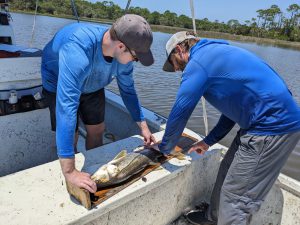Written by 2023 Undergraduate Intern Seth Keep, hosted by the Florida Fish and Wildlife Conservation Commission
What is FIM?

As an NCBS summer intern, I had the amazing opportunity of working alongside the Fisheries-Independent Monitoring (FIM) team of the Florida Fish and Wildlife Conservation Commission (FWC) in Cedar Key. Here, I gained both valuable experience and respect for the vital work that is being done to monitor and ensure healthy fish habitats and populations.

In the Field
One of our important FIM duties was conducting stratified-random sampling (SRS) each month in estuarine regions around Cedar Key to estimate fish abundance and population trends. Our sampling “universe” consisted of divided zones that contained various habitat types. Each month, sites would be randomly selected within these zones and a variety of sampling gears/techniques would be utilized to ensure a wide and accurate range of data was collected. Some of the gear types that we used included small/large seines and otter trawls. Depending on the water depth, habitat type, or shore type, a variety of techniques were further employed.
We also recorded both physical and biological data relevant to the site we were sampling. We would describe the physical features of the site by recording water quality parameters (e.g., temperature, pH, salinity, dissolved oxygen) and documenting both the submerged and shoreline habitats present. Once our nets were deployed and retrieved, we would record the biological data from the set. All the fish and invertebrates that we collected were identified, measured, and counted, and a representative subsample was taken back to the lab for further work-up. This was a great hands-on experience, and it was always rewarding to deploy the nets and be able to handle all the fish species – both the common and the rare finds.

In the Lab
Another important part of our FIM duties involved working with the data that we collected in the field. This included entering and verifying the data we collected; both what we recorded and the samples that we took. From selected fish species we would extract otoliths or take tissue samples that would be used for mercury concentration, ageing, diet, reproduction, and genetic studies. From our representative sub-samples, we would utilize microscopes and dichotomous keys to either identify or verify the species. This was an intriguing opportunity to study the meristic features of fish and I learned to appreciate the subtlety of their anatomy that arguably otherwise goes unnoticed. I learned a lot from this experience and was able to familiarize myself with both the proper lab techniques and the names of numerous fish species. In fact, I am sure I will be taking Lagodon rhomboides with me forever!
In Conclusion
Part of what made this experience so rewarding was not only how much I learned, but the opportunity to step into the world of marine science research and contribute towards better management that ensures the well-being of fish populations. I want to thank everyone at the FWC FIM team for an amazing summer, and a special thanks to NCBS for making it all possible!

| Follow the link to learn more about the UF/IFAS NCBS Undergraduate Summer Internship program. Read more intern blogs here. |
 1
1
